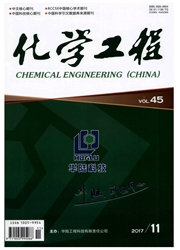

 中文摘要:
中文摘要:
以鸡西油页岩为原料,利用热重分析仪进行了3种不同升温速率的干燥试验。结果表明:干燥速率随干基含水率的变化曲线分成3个阶段;对于含水率wX〉wXA阶段,是表面水蒸发干燥过程,主要受物理脱附作用影响;wXA〉wX〉wXB阶段,失去的水分是较大毛细孔内的水,主要受油页岩样品体积收缩和内部毛细孔浓缩共同作用影响;wXB〉wX〉0阶段,这一阶段的主要是小毛细孔和中孔水分的蒸发。有效水分扩散系数有3段不同变化趋势,开始急剧增长,随之增长平缓,最后下降;在干燥的末端出现一个明显的突变点,该点之后有效水分扩散率有一个明显的激增。干燥速率随着升温速率的增加而增加;同时随着升温速率的增加水分有效扩散系数升高和降低趋势更加明显。
 英文摘要:
英文摘要:
Oil shale from Jixi City was subjected to thermo-gravimetric drying experiments at three different heating rates. The results show that the curve of drying rate with the water content is divided into three stages. When the water rate of oil shale wX wXA,the surface moisture is distillated and dried due to the influence of physical desorption. When wXA wX wXB,the primary loss of moisture is the internal water inhabiting relatively large pores,mainly affected by oil shale sample volume shrinkage and the internal pores concentrated. Finally when wXB wX 0,this phase evaporation mainly occurrs in the hole and small capillary pores of oil shale. The effective diffusion coefficient of water had three different trends,begun to rise sharply,then growth flat,last fall. Based on the sudden evaporation of moisture in the pores during the late stage,the moisture' s effective diffusivity presented an inflection point,after which the effective diffusivity rose. The drying rate increased with the increase of heating rate. At the same time,the increasing and decreasing trends of the effective diffusion coefficient of water were more obvious with the increase of heating rate rising.
 同期刊论文项目
同期刊论文项目
 同项目期刊论文
同项目期刊论文
 期刊信息
期刊信息
